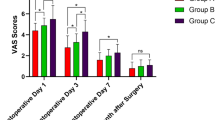Abstract
This study reports the results of the clinical use of a new tourniquet system for surgery of foot and ankle that can determine tourniquet pressure in synchrony with systolic blood pressure (SBP). We prospectively applied additional pressure of 100 mmHg based on the SBP recorded before the skin incision in 100 consecutive procedures. There were 34 open reduction internal fixation procedures, 26 lateral colateral ligament repair or reconstruction, 16 Achilles tendon repairs, nine arthroscopic procedures such as removal of loose body or accessory bone and synovectomy, seven corrective osteotomy and eight others such as removal of tumour, ankle fusion, and bone graft. The average initial tourniquet pressure was 211 mmHg. The average maximum SBP change during surgery was 28 mmHg. All cases maintained an excellent operative field without measurable bleeding and there were no postoperative complications. Fifty-five cases had a lower intra-operative SBP than the initial value. Since a tourniquet should be applied at the lowest pressure possible for maintaining a bloodless surgical field, the new system appears to be practical and reasonable, as compared to conventional tourniquets, which maintain the initial pressure.

Similar content being viewed by others
References
Derner R, Buckholts J (1995) Surgical hemostasis by pneumatic ankle tourniquet during 3027 podiatric operations. J Foot Ankle Surg 34:236–246
Graham B, Breault MJ, McEwen JA, McGraw RW (1993) Occlusion of arterial flow in the extremities at subsystolic pressures through the use of wide tourniquet cuffs. Clin Orthop 286:257–261
Ishii Y, Matsuda Y (2005) Effect of tourniquet pressure on perioperative blood loss associated with cementless total knee arthroplasty: a prospective, randomized study. J Arthroplasty 20:325–330
Ishii Y, Noguchi H, Matsuda Y, Takeda M, Higashihara T (2008) A new tourniquet system that determines pressures in synchrony with systolic blood pressure in total knee arthroplasty. J Arthroplasty 23:1050–1056
Konrad G, Markmiller M, Lenich A, Mayr E, Rüter A (2005) Tourniquets may increase postoperative swelling and pain after internal fixation of ankle fractures. Clin Orthop 433:189–194
Maffulli N, Testa V, Capasso G (1993) Use of a tourniquet in the internal fixation of fractures of the distal part of the fibula: a prospective, randomized trial. J Bone Joint Surg Am 75:700–703
Massey KA, Blakeslee C, Martin W, Pitkow HS (1999) Pneumatic ankle tourniquets: physiological factors related to minimal arterial occlusion pressure. J Foot Ankle Surg 38:306–307
Moore MR, Grafin SR, Hargens AR (1987) Wide tourniquets eliminate blood flow at low inflation pressures. J Hand Surg Am 12:1006–1011
Muirhead A, Newman RJ (1986) A low-pressure tourniquet system for the lower limb. Injury 17:53–54
Neimkin RJ, Smith RJ (1983) Double tourniquet with linked mercury manometers for hand surgery. J Hand Surg Am 8:938–941
Newman RJ, Muirhead A (1986) A safe and effective low-pressure tourniquet: a prospective evaluation. J Bone Joint Surg Br 68:625–628
Omeroğlu H, Günel U, Biçimoğlu A, Tabak AY, Uçaner A, Güney O (1997) The relationship between the use of tourniquet and the intensity of postoperative pain in surgically treated malleolar fractures. Foot Ankle Int 18:798–802
Pauers RS, Carocci MA (1994) Low pressure pneumatic tourniquets: effectiveness at minimum recommended inflation pressures. J Foot Ankle Surg 33:605–609
Reid HS, Camp RA, Jacob WH (1983) Tourniquet hemostasis. A clinical study. Clin Orthop 177:230–234
Tejwani NC, Immerman I, Achan P, Egol KA, McLaurin T (2006) Tourniquet cuff pressure: the gulf between science and practice. J Trauma 61:1415–1418
Tuncali B, Karci A, Bacakoglu AK, Tuncali BE, Ekin A (2003) Controlled hypotension and minimal inflation pressure: a new approach for pneumatic tourniquet application in upper limb surgery. Anesth Analg 97:1529–1532
Younger AS, Kalla TP, McEwen JA, Inkpen K (2005) Survey of tourniquet use in orthopaedic foot and ankle surgery. Foot Ankle Int 26:208–217
Younger AS, McEwen JA, Inkpen K (2004) Wide countered thigh cuffs and automated limb occlusion measurement allow lower tourniquet pressures. Clin Orthop 428:286–293
Author information
Authors and Affiliations
Corresponding author
Rights and permissions
About this article
Cite this article
Ishii, Y., Noguchi, H. & Takeda, M. Clinical use of a new tourniquet system for foot and ankle surgery. International Orthopaedics (SICOT) 34, 355–359 (2010). https://doi.org/10.1007/s00264-009-0804-3
Received:
Revised:
Accepted:
Published:
Issue Date:
DOI: https://doi.org/10.1007/s00264-009-0804-3




